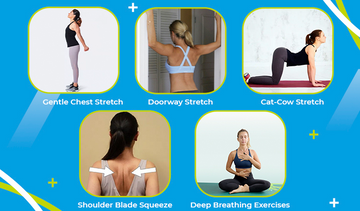Costochondritis is a condition that can cause significant discomfort and pain in the chest area. This condition, characterized by inflammation in the cartilage that connects your ribs to the breastbone, can make everyday activities challenging. Fortunately, there are exercises for costochondritis that can help alleviate the pain and improve your quality of life. In this blog post, we will explore some effective costochondritis stretching exercises that can provide relief and promote healing.
What Is Costochondritis?

Costochondritis is a common condition that often mimics the symptoms of a heart attack. The pain associated with costochondritis typically occurs in the chest area, especially around the sternum or breastbone. It can be sharp, stabbing, and exacerbated by movements like deep breathing, coughing, or stretching. While the exact cause of costochondritis is not always clear, it is often related to injury, strain, or infections.
Exercises for Costochondritis
Gentle Chest Stretch:
- Stand tall with your feet shoulder-width apart.
- Interlace your fingers behind your back and gently lift your arms, keeping them straight.
- Hold this position for 15-20 seconds while taking deep breaths.
- Repeat this stretch a few times a day to improve chest flexibility.

Doorway Stretch:
- Stand in a doorway with your feet positioned slightly in front of the frame.
- Place your hands on either side of the door frame at shoulder height.
- Lean your body forward slightly to feel a gentle stretch across your chest.
- Hold for 15-20 seconds and repeat as needed.

Cat-Cow Stretch:
- Get on your hands and knees, with your wrists aligned under your shoulders and knees under your hips.
- Inhale as you arch your back and look up (Cow Pose).
- Exhale as you round your back and tuck your chin (Cat Pose).
- Perform this stretch slowly and gently for a few rounds to relieve tension in the chest area.

Shoulder Blade Squeeze:
- Sit or stand with your back straight.
- Gently squeeze your shoulder blades together, as if trying to hold a pencil between them.
- Hold for 10-15 seconds and release.
- Repeat this exercise several times a day to improve posture and alleviate chest discomfort.

Deep Breathing Exercises:
- Sit comfortably with your back straight.
- Inhale deeply through your nose, expanding your chest and ribcage.
- Exhale slowly through your mouth, relaxing your chest.
- Deep breathing can help relax the chest muscles and reduce pain associated with costochondritis.

Conclusion
Costochondritis can be a painful and frustrating condition, but incorporating these exercises for costochondritis into your daily routine can help you manage your symptoms and promote healing. Remember to start slowly, listen to your body, and consult with a healthcare professional if you have any concerns or if your symptoms worsen.
By regularly practicing costochondritis stretching exercises and maintaining good posture, you can gradually ease the discomfort and regain your quality of life. Be patient with yourself and prioritize self-care to support your journey towards a pain-free chest.





